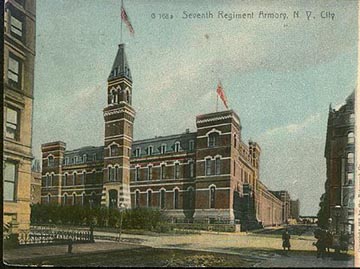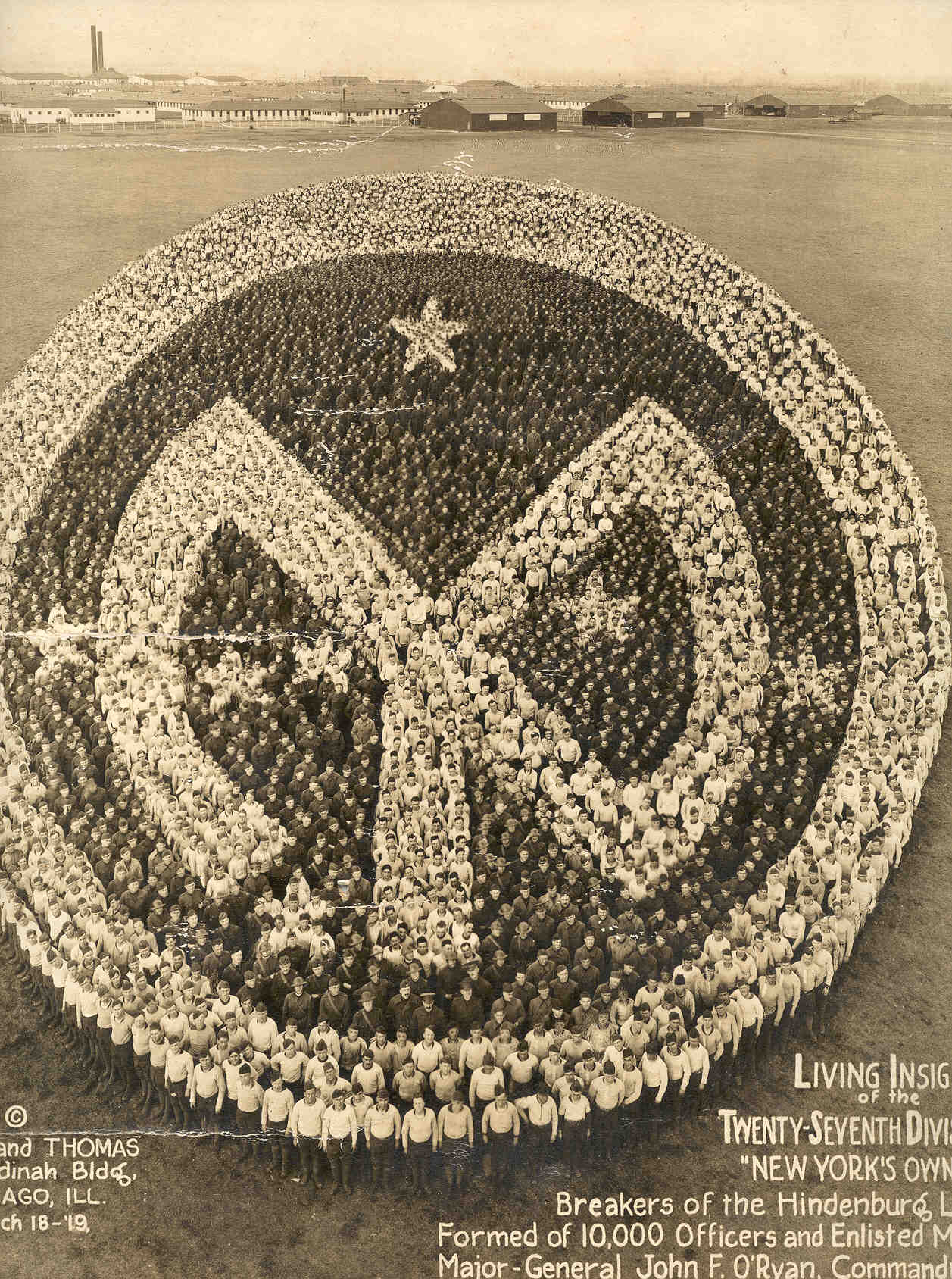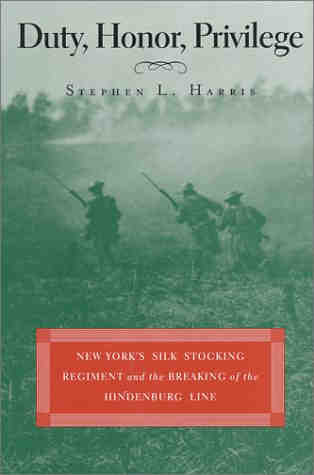 1806-1916
The Seventh Regiment came into being in April, 1806. Three British warships stood off New York harbor and waylaid all vessels trying to enter. The heightened tensions between New York and its former masters led to a rush of enlistments in the New York Volunteer militia companies. Four of these companies, combined into a battalion were the ancestors of the Seventh. In July they were assigned to the Battalion of Artillery, one of the elite Volunteer units in the City.
For a 3 year period between 1812 and 1815 the unit, now designated the 2nd Battalion 11th Artillery, manned the guns of the forts guarding New York harbor.
In 1824 the Second Battalion, 11th Artillery tried to secure a separate status. In honor of a visit by Lafayette in that year it was decided they would call themselves National Guards (the "s" was dropped in 1832) in honor of the unit by that name formed and commanded by Lafayette in Paris. The name was adopted in August of that year. That same year the regiment adopted a grey uniform and has since been known as the "Grey Jackets" or "Grey-Backs." In 1825 the unit was made a separate battalion. Having expanded from 4 to 8 companies it was also reorganized in 1826 as the 27th Regiment, New York State Artillery. In 1847 the militia system was overhauled and as a result, the 27th was renumbered as the 7th regiment, NYS Militia on 27 July, 1847.
CLICK HERE TO VIEW EARLY UNIFORMS OF THE REGIMENT
The Regiment was called up as 3 month Volunteers during the first months of the Civil War. It was on guard in the forts around Washington for three months in 1861 and called up 2 more times during the war. The last call in 1863 was cut short in order to bring the regiment back to NYC to quell the Draft Riots. The regiment never served in battle but over 200 of its officers served in the field in other units during the war.
By 1876 the 7th had outgrown it's Tompkin's Market armory. Funds were raised and construction was commenced late in 1877 on the new armory on Park Avenue and 66th Street. The regiment moved in amid great ceremony in April, 1880 (and remains there to this day.) 
1909 Postcard image of the 7th Regiment Armory
In 1916, the regiment was called into Federal Service on the Mexican Border as part of a force of 156,000 Guardsmen. This was, in effect, a test which showed up deficiencies in organization and personnel of the entire National Guard system. These deficiencies would need to be corrected, and soon. The Seventh, when called, reported for duty with all of its 1106 members and served five months in the field in and around McAllen, Texas. National Guard troops saw no action on the border and most of their time was spent on training hikes and maneuvers. Three members of the regiment died of unspecified causes while serving on the border.
THE GREAT WAR

WAR DEPARTMENT
Washington, July 12, 1917
General Orders, No. 90
"Whereas the United States of America and the Imperial German Government are now at war...I, Woodrow Wilson, President of the United States...call into service...all members of the National Guard...of the following states...
I. On July 15, 1917, New York, Pennsylvania, Ohio..."
With these words the 7th Regiment, New York National Guard began a long journey that would take it to France and Belgium and some of the world's most famous battlefields.
With the July 15th call-up, a period of stepped up training and drill began. The Regiment marched daily from the Armory on Park Avenue to the parade ground in Central Park for drill. Maneuvers took place on the Sheep Meadow. On August 5th, by proclamation, all officers and enlisted men of the National Guard were drafted into Federal service. They really were "in the Army now..." On September 11, the Regiment entrained for Camp Wadsworth, Spartanburg, S.C.
MAP OF CAMP WADSWORTH
The 107th Infantry came into existence at Camp Wadsworth by an order issued from headquarters, 27th Division, October 1,1917. This order changed the designation of the 7th New York Infantry to the 107th Infantry, U.S. Army, assigning the Regiment with the 108th Infantry to the 54th Brigade of the 27th Division, "The New York Division." By the reorganization the 107th Infantry received from the 1st New York Infantry 1600 men; from the 12th N.Y. 320 men and from the 10th N.Y. and a few other Regiments, small detachments. The upstaters, mostly from the Mid-Hudson Valley and the Utica area were known as the "Appleknockers". The training period at Camp Wadsworth lasted until April 28, 1918 when the Regiment entrained for Camp Stuart at Newport News, Virginia where on May 9 and 10 the Regiment sailed for France onboard the S.S. Susquehanna and the S.S. Antigone. The Regiment, 3700 men strong, arrived on May 24 and 25 at Brest and proceeded on foot to Camp Pontanezen, the reception camp for most AEF troops arriving in France.

Headquarters Company guidon, 107th Infantry
Journal entry of Andrew R. Todd, Sgt, Co. L
"We arrived in France on Friday, May 25th at a place called Brest. We stayed in Brest for 2 days and on Sunday morning of the 26th we got on a train road(sic) for 2 days and landed in a place called Noyelles. We stayed there one day and left and walked to a town called Favieres. We got here 28 May and left on Monday June 17 we walked 22 miles and left there on June 20 for the front. In Noyelles we were greeted the first night with a few bombs."
The Division was assigned to the British 2nd and later, the 4th Army. The unit underwent several weeks of training in the Noyelles-St Omer area. Later they moved to the Ypres Salient Reserve Area northeast of Cassel. By the end of July, the unit was ready for some practical experience on the East Poperinghe Line, part of the Ypres Salient in Belgium. A week later they moved into positions around Dickebusch Lake, taking over sectors formerly occupied by the 6th and 41st British divisions. As the Second American Army Corps, the 27th Division, along with the 30th, took part in attacks around the German strongpoints at Mt Kemmel on September 1 & 2. As a result of the wedge they drove behind Mt Kemmel the enemy evacuated this position. After 2 days of fighting the unit was withdrawn and taken south for a rest and more training. They had been in the trenches for about 6 weeks at that time and had sustained casualties of 29 killed and 159 wounded or gassed. The unit spent two weeks south of Toulons practicing assault tactics and on September 25th they occupied positions in front of the St. Quentin Canal tunnel, part of the Hindenburg Line.
At 4 AM on September 29, the 107th Regiment began its approach to the jumping off line. The attack commenced at 6 AM and lasted 2 days; by the time the 107th was relieved it had lost 22 officers killed or wounded, 324 men killed and 874 wounded. But the attack succeeded. It had broken the Hindenburg line. Four men of the 107th Regiment would earn the Medal of Honor on the 29th of September. 
"THE GLORIOUS 27TH"
New York's Own Piercing the Hindenburg Line
F. Matania, © New York Herald 1919
READ LT. BUELLS ACCOUNT OF THE ATTACK
More fighting would follow; LaSelle River, Jonc De Mer Ridge and St. Maurice River. Before it was all over the Regiment would lose a total of 580 men killed and 1487 wounded.
The regiment was recovering near Amiens when the Armistice was announced. The regiment returned to New York in March of 1919 where on the 25th it marched up 5th Avenue in the Victory Parade. The regiment was mustered out of Federal Service at Camp Upton, Long Island on April 2, 1919.

Living Insignia of the 27th Division, an image formed by over 10,000 unit members taken just after they returned from France.
Thanks to Tom Marino

Click on the book cover for the complete book in pdf format
 DUTY, HONOR, PRIVILEGE
NEW YORK'S SILK STOCKING REGIMENT and the BREAKING of the HINDENBURG LINE
by STEPHEN L. HARRIS 
click on image for review from
NATIONAL GUARD MAGAZINE
This is an outstanding work of research on the 107th Infantry in the Great War. The author is the great-nephew of Raeburn Van Buren who you should recognize as art editor of the Gas Attack. The author relies a great deal on first person accounts, many from family letters and articles written for the Seventh Regiment Gazette shortly after the events took place. It is an extremely readable and compelling account of the 107th's defining moment in history. If you only own one history of the regiment, this should be it.

BORROWED SOLDIERS
By MITCHEL YOCKELSON

click on the book for the Borrowed Soldiers website


|